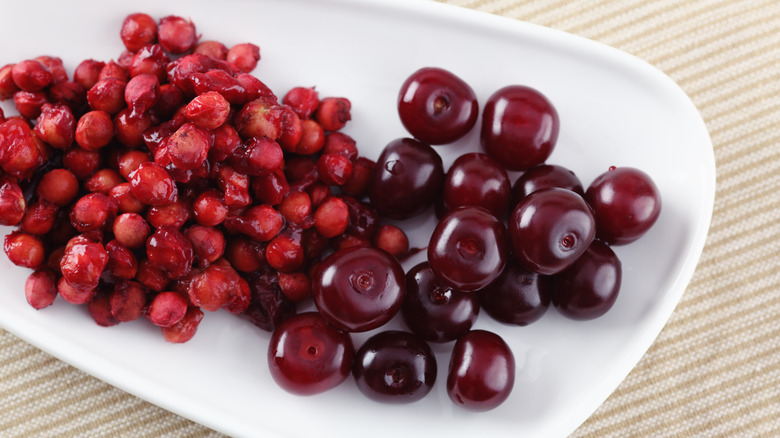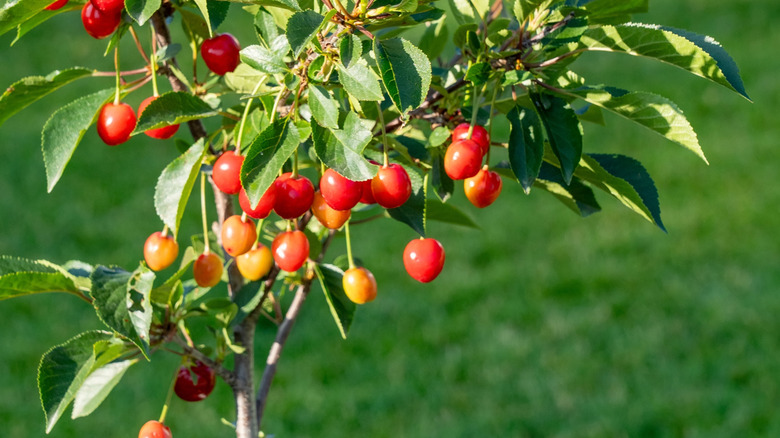How To Choose The Best Cherry Seed To Plant & Grow In Your Yard
Growing cherries from seed can be a fun gardening experiment — and one that might just yield some delicious results. But before you plant any old cherry seed in your yard, there are a few things to consider to give it the best chance of growing into a thriving tree. The first (and possibly most important) step is deciding where to buy the cherries you'll get your seeds from. Grabbing a bag from the grocery store might seem like an obvious choice, but it's actually not advisable. This is because there's a good chance those cherries were imported from a region with a different climate, and therefore may not thrive in your area. Some may also have been refrigerated or are complex hybrids that could be sterile. You'll have much better luck with seeds from fresh cherries bought at a local farmers' market or picked from a tree naturally growing nearby.
Climate is a very important thing to think about when choosing which type of cherry seed to plant. There are at least 16 varieties of cherries that you can plant and grow in your garden, and not all will do well in the area where you live. Sweet cherry varieties like 'Bing' and 'Rainier' (Prunus avium), for example, do best in areas with warmer climates and milder winters — places like Utah and Tennessee. Tart cherries like Morello (Prunus cerasus) and its cultivar 'Montmorency', however, can tolerate areas with cooler climates, like Minnesota and Michigan — the latter of which has a city known as the cherry capital of the world.
Is your garden a better home for sweet or tart cherry seeds?
In general, cherry trees are adapted to grow in cold climates, and most will do well in USDA Hardiness zones 4 through 8, depending on the variety. Cherry trees require a certain number of dormant "chill hours" to blossom and fruit properly, so there are only a few varieties that can be grown in southern states, including Prunus avium 'Royal Lee' and Prunus avium 'Minnie Royal.' When figuring out which cherry seed varieties are most compatible with your climate, sunlight is an important factor to consider as well. Sweet cherries need lots of sunlight — about six to seven hours a day — to build up their sugar content. Tart cherries, on the other hand, can handle a little more shade.
Where you plan on planting your cherry seeds matters, too, as some seeds will need more space to grow. Some sweet cherries, for instance, can't pollinate themselves, and will need a second compatible tree nearby for cross-pollination. In other words, if you're wanting to grow sweet cherries from seed, you may need a slightly more spacious garden than if you were growing tart cherries, which are self-fertile. It's also worth noting that the best time to harvest your cherries will depend on the variety. Sweet cherries like 'Bing' and 'Rainier', for example, are typically ready for picking in early July, while tart cherries like 'Montmorency' sometimes aren't ready until August. So, if you go away on holiday every August, a tart cherry variety might not be the best choice.
Preparing and planting your chosen cherry seeds
Once you've narrowed down which variety of cherry seed will work best for you and your garden, it's time for the most exciting part: planting! The easiest step in this process is, of course, snacking on your chosen cherry variety to reveal the pits you're going to plant. The next step is to soak them in warm water for a few minutes. This will help to clean them and remove any of the remaining flesh, prevent mold growth, and ultimately get them in the best shape for planting.
To give your seeds the best chance of success, it's also important to expose them to cold before planting them, also known as cold stratification. To do this, simply store the seeds in a container or bag with damp peat moss or sand, and place in the fridge for about three months. When you're ready, start by planting them in small containers filled with potting soil to germinate (make sure to plant several seeds per container).
Once they germinate, remove the weaker cherry seedlings from each container to allow the strongest ones to grow until they reaches 8 to 12 inches tall, at which point they'll be ready to transplant to your outdoor garden. The best time to do this depends on your climate, but it's recommended to wait until the spring when frost is completely gone. Although growing cherries from seed is a lengthier and more complicated process than simply planting an established cherry tree or sapling, it's definitely not impossible. And in the end, you'll be rewarded with fresh, home-grown fruit that both gardeners and birds can enjoy.


